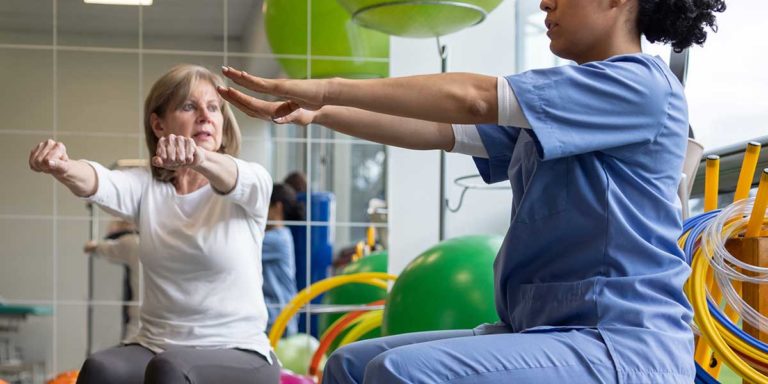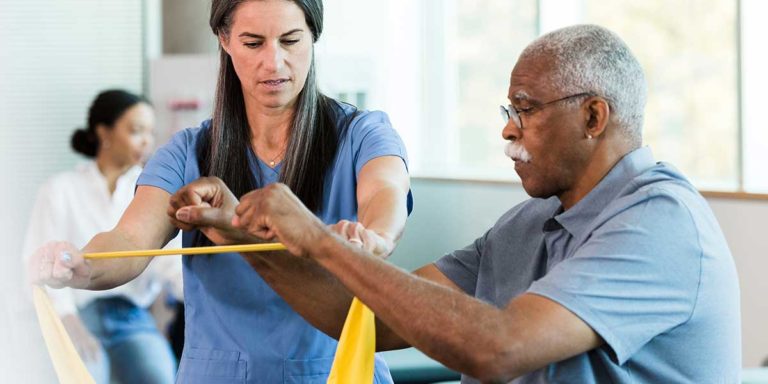The 5 Most Common Types of Physical Therapy
Although most people think of physical therapy (PT) merely as a rehabilitative method to help individuals who have sustained injuries, PT is much more. Physical therapy is a health science designed to address numerous conditions related to the motor and posture of the body. Due to PT’s wide range of applications, it is divided into subspecialties. Therefore, the treatments and instruments a physical therapist employs depends on the reason an individual is receiving physical therapy.
What Are the 5 Most Common Types of Physical Therapy?
These five physical therapy subspecialties are designed to appropriately and effectively address specific pathologies and ailments to rehabilitate the body.
1. Occupational Therapy (OT)
Occupational PT is for individuals who have work-related injuries that do not result from an accident. Since back injuries, due to improper lifting, make up one of every five workplace illnesses or injuries, OT frequently concentrates on teaching employees how to lift using their leg muscles, instead of their back. In addition, this type of therapy helps individuals recognize and then correct poor posture. Furthermore, occupational therapy also places a focus on strengthening the core and upper body. A strong core helps provide support for the back.
2. Pediatric Physical Therapy
Pediatric PT focuses on conditions affecting specific age groups.
Some injuries and diseases pediatric physical therapy can assist with include:
- Birth defects.
- Genetic disorders.
- Acute injuries.
- Developmental delays.
- Orthopedic disabilities.
- Head trauma.
- Muscle diseases.
- Limb deficiencies.
When a child has difficulty learning, or experiences problems with natural movement, early intervention can prevent future problems from arising. Therefore, if your child has or is experiencing any of the issues listed above, please make an appointment with a pediatric physical therapist today. To schedule an appointment at Therapeutic Potentials, Inc. (TPI), call 941-758-3140.
Pediatric PT can help with:
- Improving both fine and gross motor skills.
- Alleviating pain.
- Improving range of motion.
- Regaining strength.
- Mastering body mechanics to improve balance and flexibility.
3. Geriatric Physical Therapy
As time passes, the body becomes less nimble. This loss of agility can be troublesome, especially when coupled with some other condition that negatively affects a Senior’s ability to move naturally.
Geriatric PT addresses issues related to movement and mobility, including those resulting from musculoskeletal conditions.
Common ailments a geriatric physical therapist treats include:
- Arthritis.
- Alzheimer’s disease.
- Balance issues.
- Cancer.
- Rehabilitation following joint replacement surgery.
- Osteoporosis.
In addition, physical therapy for Seniors may include performing easy exercises to help the patient stay fit.
The goal of geriatric physical therapy is to improve the patient’s range of motion and reduce the amount of pain he or she experiences while making particular movements.
4. Neurological PT
Neurological physical therapy focuses on assisting individuals who have a neurological condition or impairment. Neurological conditions are those that affect the spinal cord, brain and overall nervous system. Patients learn how to adapt to impairments affecting their vision, balance, muscles and mobility.
Although most neurological conditions are chronic (i.e., incurable), physical therapy can help reduce the activity limitations resulting from a stroke, Multiple Sclerosis, Alzheimer’s and Parkinson’s disease, as well as brain and spinal cord injuries.
5. Orthopedic Physical Therapy
This physical therapy subspecialty concentrates on restoring the function of the musculoskeletal system (i.e., tendons, joints, bones and ligaments). Sports injuries usually fall within this category.
Treatment a patient may receive during an orthopedic physical therapy session includes:
- Strength training.
- Stretching.
- Hot and cold therapy.
- Exercises to build endurance.
- Electrical muscle stimulation (EMS).
- Therapeutic ultrasound.
- Joint mobilization.
Orthopedic physical therapy can help relieve pain, correct skeletal damage and increase mobility.
If you are experiencing limitations due to a condition or injury, one of the experienced physical therapists at Therapeutic Potentials, Inc., may be able to help. To schedule an initial consultation, please call 941-758-3140, or click here for our online form. TPI serves individuals who reside in Bradenton, Sarasota and Lakewood Ranch, Florida, as well as those in the surrounding areas.







